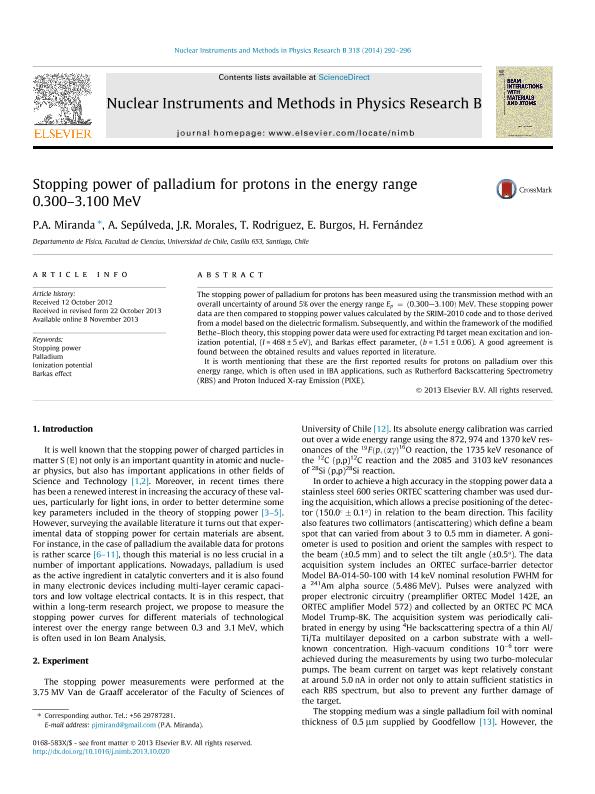Artículo
Stopping power of palladium for protons in the energy range 0.300–3.100 MeV
Miranda, P. A.; Sepúlveda, A.; Morales, J.R.; Rodriguez Cabello, Tabatha Pamela ; Burgos, E.; Fernandez, H.
; Burgos, E.; Fernandez, H.
 ; Burgos, E.; Fernandez, H.
; Burgos, E.; Fernandez, H.
Fecha de publicación:
01/2014
Editorial:
Elsevier Science
Revista:
Nuclear Instruments and Methods in Physics Research B: Beam Interactions with Materials and Atoms
ISSN:
0168-583X
Idioma:
Inglés
Tipo de recurso:
Artículo publicado
Clasificación temática:
Resumen
The stopping power of palladium for protons has been measured using the transmission method with an overall uncertainty of around 5% over the energy range Ep=(0.300–3.100) MeV. These stopping power data are then compared to stopping power values calculated by the SRIM-2010 code and to those derived from a model based on the dielectric formalism. Subsequently, and within the framework of the modified Bethe–Bloch theory, this stopping power data were used for extracting Pd target mean excitation and ionization potential, (I = 468 ± 5 eV), and Barkas effect parameter, (b = 1.51 ± 0.06). A good agreement is found between the obtained results and values reported in literature. It is worth mentioning that these are the first reported results for protons on palladium over this energy range, which is often used in IBA applications, such as Rutherford Backscattering Spectrometry (RBS) and Proton Induced X-ray Emission (PIXE).
Palabras clave:
Stopping Power
,
Palladium
,
Ionization Potential
,
Barkas Effect
Archivos asociados
Licencia
Identificadores
Colecciones
Articulos(IFEG)
Articulos de INST.DE FISICA ENRIQUE GAVIOLA
Articulos de INST.DE FISICA ENRIQUE GAVIOLA
Citación
Fernandez, H.; Burgos, E.; Rodriguez Cabello, Tabatha Pamela; Morales, J.R.; Sepúlveda, A.; Miranda, P. A.; et al.; Stopping power of palladium for protons in the energy range 0.300–3.100 MeV; Elsevier Science; Nuclear Instruments and Methods in Physics Research B: Beam Interactions with Materials and Atoms; 318B; 1-2014; 292-296
Compartir
Altmétricas



